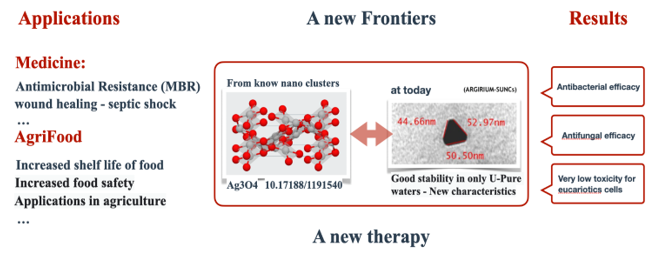Video Article Open Access
Amazing Nanoclusters for A New Therapy in Antimicrobial Resistance
Luca Scotti*, Antonio Aceto
Department of Medical, Oral and Biotechnology - University of Chieti-Pescara, Italy
Vid. Proc. Adv. Mater., Volume 3, Article ID 2206278 (2022)
DOI: 10.5185/vpoam.2022.06278
Publication Date (Web): 12 Sep 2022
Copyright © IAAM
Graphical Abstract

Abstract
This oral presentation aims to present a new frontier for a new therapy vs traditional antimicrobial. A deeply investigate of the structure and properties of new synthesized silver ultra-nanoparticles (ArgiriumTM-SUNCs) through high-resolution techniques such as transmission electron microscopy (TEM), scanning electron microscopy (SEM), Zeta Potential measurements, and matrix-assisted laser desorption/ionization-time of flight mass spectrometry (MALDI-TOF-MS) provided therapeutics evidence. Strong brightness, tendency to generate nanoclusters containing an odd number of atoms, and absence of the free silver ions in solution was observed. The research also highlighted that the singular chemical and physical properties of the ArgiriumTM-SUNCs seemed to be related to their peculiar oxidative state as suggested by X-ray photoelectron spectroscopy (XPS) and X-ray powder diffraction (XRPD) analyses. The MTT assay revealed the low cytotoxicity of the investigated ArgiriumTM-SUNCs and make evidence of affiance of SUNCs at very low concentration vs bacteria and fungi (< 1 ppm). We will propose this nanocomposite as a new application for innovative pharmacological therapy in more fields (Agrifood-biomedical).
Keywords
Antimicrobial resistance (AMR), nanolcusters, antimicrobial therapy, chemical physical properties.
Acknowledgement
We thank University of Chieti-Pescara, Italy for the grant.
References
- Bernardo, M.-H. J.; Antonio, A.; Tonino, B.; Domenico, P.; Luca, V.; Katiuscia, Z.; Luca, S.; Clemencia, C.-L., The membrane depolarization and increase intracellular calcium level produced by silver nanoclusters are responsible for bacterial death. Articolo in Rivista, 2021, 11, 21557.
- Arianna, P.; Cristina, G.; Domenico, B.; Rosalba, R.; Antonio, A.; Tonino, B.; Luca, S.; Giovanni, D. B., Electrochemically synthesized silver nanoparticles are active against planktonic and biofilm cells of Pseudomonas aeruginosa and other cystic fibrosis-associated bacterial pathogens. Articolo in Rivista 2018, 9, 1349.
- Carla, G.; Maurizio, R.; Antonio, A; Luca, S., Structure and Properties of Electrochemically Synthesized Silver Nanoparticles in Aqueous Solution by High-Resolution Techniques. Molecules, 2021, 26, 5155.
- Luca Scotti, G. A., Carla Gasbarri and Tonino Bucciarelli, Uncoated negatively charged silver nanoparticles: Speeding up the electrochemical synthesis. Materials Research Express, 2017, 4 (10).
Biography
Luca Scotti has completed his PhD from University of Chieti-Pescara, Italy and BSc. Chemistry at University of Milano, Italy and Post-Doc position at WAustralia University. He worked in a multinational drug company for several years as a Senior Researcher, achieving numerous results in the organic synthesis of new Active Pharmaceuticals ingredients (APIs). He is the inventor of 3 patents of new nanomaterials and registered in the international database (CIDD) many new organo-metallic molecules. Today is Professor and PI of Biochemistry at department of Medical, Oral and biotechnology (DSMOB), Italy. He has over 30 publications that have been cited over 300 times, and his publication h-index is 12. He has been serving as an editorial board member and topics member of several reputed journals.
Video Proceedings of Advanced Materials

Upcoming Congress



